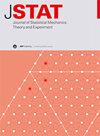Confined granular gases under the influence of vibrating walls
IF 2.2
3区 物理与天体物理
Q2 MECHANICS
Journal of Statistical Mechanics: Theory and Experiment
Pub Date : 2023-12-29
DOI:10.1088/1742-5468/ad0828
引用次数: 0
Abstract
In this paper we study the dynamics of a system composed of inelastic hard spheres or disks that are confined between two parallel vertically vibrating walls (the vertical direction is defined as the direction perpendicular to the walls). The distance between the two walls is supposed to be larger than twice the diameter of the particles so that the particles can pass over each other, but is still much smaller than the dimensions of the walls. Hence, the system can be considered to be quasi-two-dimensional (quasi-one-dimensional) in the hard spheres (disks) case. For dilute systems, a closed evolution equation for the one-particle distribution function is formulated that takes into account the effects of the confinement. Assuming the system is spatially homogeneous, the kinetic equation is solved approximating the distribution function by a two-temperature (horizontal and vertical) Gaussian distribution. The obtained evolution equations for the partial temperatures are solved, finding a very good agreement with molecular dynamics simulation results for a wide range of parameters (inelasticity, height and density) for states whose projection over a plane parallel to the walls is homogeneous. In the stationary state, where the energy lost in collisions is compensated by the energy injected by the walls, the pressure tensor in the horizontal direction is analyzed and its relation with an instability of the homogeneous state observed in the simulations is discussed.受振动壁影响的密闭颗粒气体
在本文中,我们研究了一个由非弹性硬球或硬盘组成的系统的动力学,该系统被限制在两面平行垂直振动的墙壁之间(垂直方向定义为垂直于墙壁的方向)。两壁之间的距离应该大于颗粒直径的两倍,这样颗粒就可以互相穿过,但仍远小于壁的尺寸。因此,在硬球(圆盘)情况下,该系统可视为准二维(准一维)系统。对于稀释系统,我们提出了一个考虑到约束效应的单粒子分布函数封闭演化方程。假定系统在空间上是均质的,动力学方程的求解近似于一个双温度(水平和垂直)高斯分布的分布函数。求解得到的部分温度演化方程发现,对于在平行于壁的平面上的投影是均匀的状态,在广泛的参数(非弹性、高度和密度)范围内与分子动力学模拟结果非常一致。在碰撞损失的能量由壁注入的能量补偿的静止状态下,分析了水平方向上的压力张量,并讨论了它与模拟中观察到的均质状态的不稳定性之间的关系。
本文章由计算机程序翻译,如有差异,请以英文原文为准。
求助全文
约1分钟内获得全文
求助全文
来源期刊
CiteScore
4.50
自引率
12.50%
发文量
210
审稿时长
1.0 months
期刊介绍:
JSTAT is targeted to a broad community interested in different aspects of statistical physics, which are roughly defined by the fields represented in the conferences called ''Statistical Physics''. Submissions from experimentalists working on all the topics which have some ''connection to statistical physics are also strongly encouraged.
The journal covers different topics which correspond to the following keyword sections.
1. Quantum statistical physics, condensed matter, integrable systems
Scientific Directors: Eduardo Fradkin and Giuseppe Mussardo
2. Classical statistical mechanics, equilibrium and non-equilibrium
Scientific Directors: David Mukamel, Matteo Marsili and Giuseppe Mussardo
3. Disordered systems, classical and quantum
Scientific Directors: Eduardo Fradkin and Riccardo Zecchina
4. Interdisciplinary statistical mechanics
Scientific Directors: Matteo Marsili and Riccardo Zecchina
5. Biological modelling and information
Scientific Directors: Matteo Marsili, William Bialek and Riccardo Zecchina

 求助内容:
求助内容: 应助结果提醒方式:
应助结果提醒方式:


